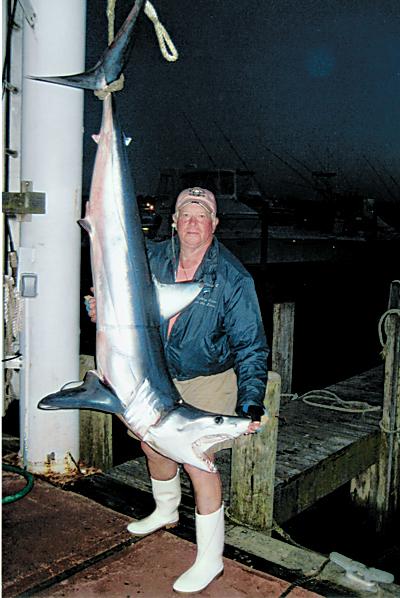Catch Big, Release Tagged

Asked if it was true that the low number of boats signed up so far for the no-kill SharkEye tournament might cause it to be canceled, Carl Darenberg of the Montauk Marine Basin, which is hosting the event, said, “If we have 10 boats, it’s enough.”
The proposed no-kill tournament and festival, scheduled for July 27 and 28, will replace the traditional chum-’em, catch-’em, and haul-’em-onto-the-scale scenario with dueling photographs and videos taken of sharks caught and brought along the side of the boats. Four sharks will be tagged with global positioning system devices so they can be tracked via satellite.
In this way, the tournament does not end with sharks being dissected by National Marine Fisheries Service scientists and steaked for distribution to the poor, with winners taking home thousands of dollars in prize money while leaving dozens of “losing” sharks dead in the tournament’s wake.
Instead, the GPS tags will allow the sharks to be tracked via computer as they continue migrations. At the Marine Basin on Monday afternoon, Capt. Julie Evans, who is helping to promote SharkEye, said that a number of Montauk’s veteran charter captains, including Michael Potts and Rick Etzel, were behind the event. She said the time had come to move away from the kill tournaments.
For years, the Marine Basin, in cooperation with the Concerned Citizens of Montauk group, has been promoting the use of circle hooks, a type developed by the Japanese to lodge in a fish’s jaw rather than a deeper place where more damage is done. The Marine Basin has also made shark tagging part of its annual tournaments.
Captain Evans runs “seacologist tours” from her 28-foot boat. She said the SharkEye event was appealing to a whole new demographic, people eager to hire boats for offshore tours, fishing yes, but also just to witness nature. “Did you know the ocean has different colors?” she asked rhetorically as an example of why, other than to kill fish, people might want to go offshore. Evans said the traditional shark tournaments had become all about big money prizes and this is keeping them alive, for now.
But, Darenberg agreed the days of the traditional shark tournament are numbered. Sharks are being overfished, and the Fisheries Service suggested last year that an eight-foot minimum catch size for all species of sharks should be implemented. He said the minimum would translate into a 200-pound blue shark, a 325-pound mako, and a 435-pound thresher — big fish, too big to make the traditional contest viable. The plan has been shelved for the time being, but it is coming.
Darenberg said the idea behind a catch-and-tag tournament began in 1979 when ABC’s American Sportsman show brought Peter Benchley, author of “Jaws,” along with the adventurer Peter Gimbel, producer Stan Waterman, and commentator Curt Gowdy off Montauk with a shark cage and a couple of scientists from the Fisheries Service’s Narragansett laboratory named Jack Casey and Wes Pratt.
“There was a dead whale down off Shinnecock. A couple of great whites had been hooked. Dick Edwards took the Patricia E. down there at night, put an anchor in the whale, and towed it to a spot southwest of Montauk,” Darenberg said. “Gene Kelly on the Sea Doll hit a [white] shark with a transmitter. My dad followed it on the Meditation, a 53-foot Hatteras. It lasted for four and a half days. It wasn’t a GPS, but it recorded body temperature, ocean temperature, and location. They learned the animal was warm blooded, big news back then.”
SharkEye will be held at the Marine Basin with Caroline Doctorow and Colton James performing. Anglers will name two of the tagged sharks, kids from the Montauk School, a third. The sharks can be tracked using the OCEARCH global shark-tracker site.
From sharks to worms. Harvey Bennett at the Tackle Shop in Amagansett was waxing poetic on Monday about the production of striped bass taken using clams and other bait along the south-facing beaches from Hither Hills to Wainscott. Although clams were working well, sand worms from Maine are magical, he said.
Trouble is, they are getting hard to get. Bennett said that, because of the recent hot spell, the worms were burrowing deeper in the mud at the mouths of rivers, where they are harvested by unionized worm diggers. And, he moaned, he’s been suffering a shortage of spearing — could it be that Harry Lester has quit bait seining, Bennett asked. The shortage had caused him to buy California smelt and Peruvian spearing for fluke bait. Both work well, especially when combined with a strip of squid. Bennett said the fluking in Gardiner’s Bay and Lake Montauk continued to be productive.
Ron Onorato, captain of the charter boat Captain Ron, returned to the dock with 9.1-pound fluke on Monday caught south of the radar tower in Montauk. He said a dozen keeper fluke were taken “with about 80 throwbacks.”
The Captain Ron also brought back a few nice black sea bass. The season for sea bass reopened on July 10.
In other news on the water, the Coastal Research and Education Society of Long Island known as CRESLI, and the Viking Fleet of Montauk have joined forces again to offer whale watching trips through September. The boat leaves the Viking Dock Sundays at 9:30 a.m. and returns at or around 3:30 p.m. The cost is $75 for adults, $49 for kids ages 5 to 12.
Recent trips have found fin whales, sea turtles, huge schools of dolphins, and all sorts of pelagic birds. Updates can be found on the CRESLI Web site at cresli.org, where reservations can be made.
